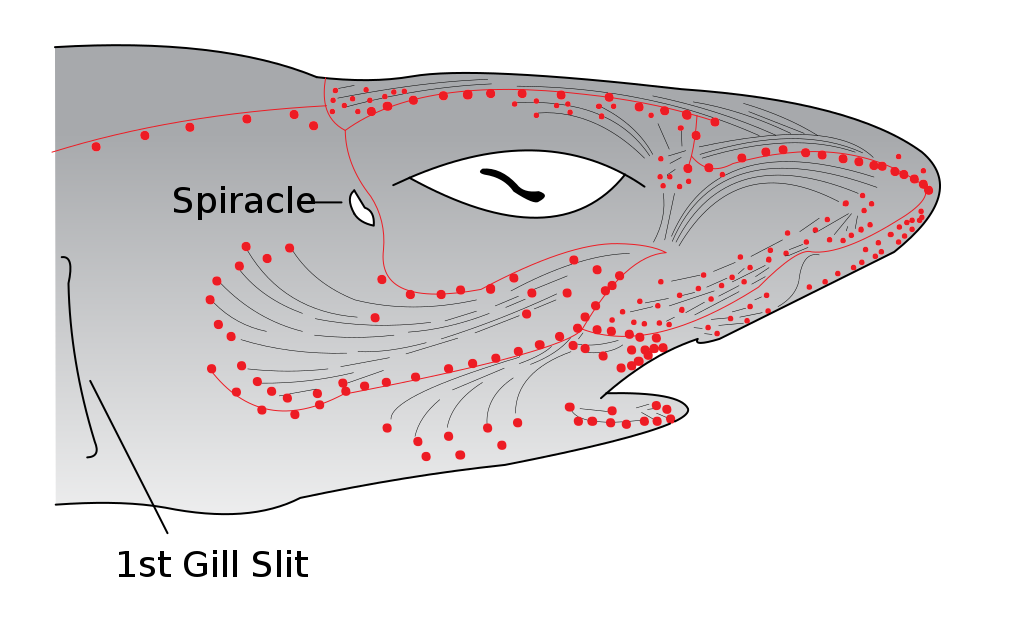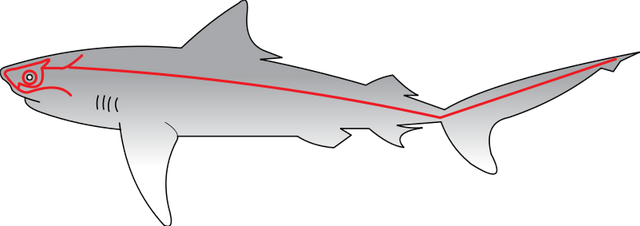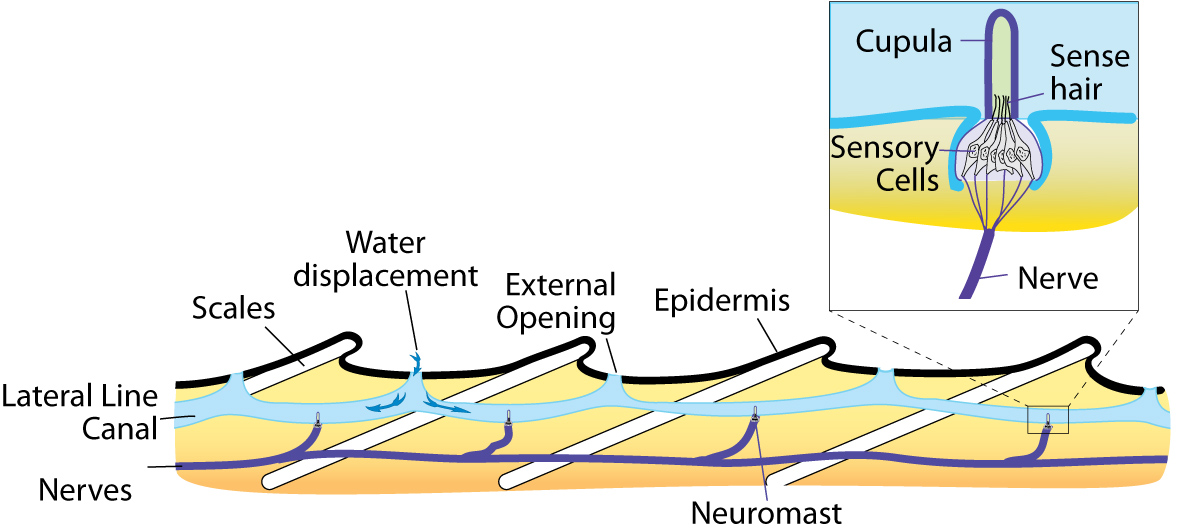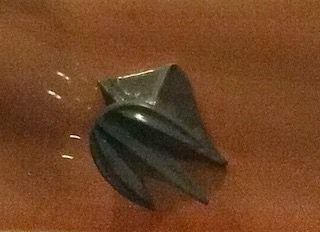PART 2 ! JAWS ! The Great White Sharks off the coast of South Africa and more...
Jump to the First Part of the Article: JAWS! The Great White Sharks off the coast of South Africa
To a shark is must be difficult to tell where the ocean stops and the shark begins. Water weaves constantly in and out of its body- water and shark moves through each other. All smells, sights, sounds, tastes and tactile (touch) stimuli come to the shark directly through its water home, with no interface or interference. Sharks live in an electromagnetic world we can’t begin to imagine. Far from being senseless beasts or incapable of feeling the knife slithering off their fins, sharks and rays are probably the most exquisitely sensitive creatures on earth. Not only do they feel things, they feel them in ways that we will never experience.

Inner view of Ampullae of Lorenzini part of the head of a Common thresher, Autor: Mdomingoa License:CC BY 4.0
Ampullae of Lorenzini.
These strange organs were discovered in the 16th century but their function wasn’t understood until recently. We now know that these ampullae can detect the electromagnetic field generated by living things making it easier for sharks to detect predators and prey. These ampullae are filled with electrically conductive jelly. At the bottom are special hair cells which respond to a local reversal of electrical polarity. A net negative charge inside the organ causes an electrical change in each hair cells, releasing neurotransmitters to nearby sensory nerves. These nerves then notify the brain which interprets the signal. Sharks also sense the earth's magnetic field and can use it as a navigational aid giving them an incredible sense of direction.

Electromagnetic field receptors (ampullae of Lorenzini) and motion detecting canals in the head of a shark, Autor: Chris_huh, License: Public domain
The ampullae of Lorenzini are astonishingly sensitive. The smooth shark (mustellus canis) can detect low-frequency electrical fields as tiny as 5 billionths of volt per square centimetre. Newborn bonnethead sharks can detect less than one nano-volt per square centimetre. This is like sensing the electrical field generated by a common flashlight battery in an area 16.000 km wide.
Pit organs consist of blind pockets in the skin containing tiny extremely sensitive hair capable of detecting minute changes in the surrounding flow and in the temperature of the water. These organs are scattered all over the surface of the sharks' body and like the lateral line, relay an incredible variety and amount of information to sharks.

Diagram of the sharks lateral line system, Autor: Chris huh License: Public domain
Sharks and other fish rely heavily on their lateral line organs to navigate in their environments. these exquisitely sensitive organs running down the length of the sharks' body on either side have no equivalent in humans. It is thought that the lateral line provides the shark with the detailed information about water movement directions, pressure, temperature and density.
Sharks' skin is a miracle of engineering. Not only does it protect the sharks' internal organs from infection and damage, anchor muscles, provide camouflage and identify the shark to others, but it has been re-engineered to make it extremely hydrodynamic or fast in the water. Sharkskin ranges from about the thickness of paper and deep-water species like the gulper lantern sharks to more than 2.5-centimeter-thick in animals such as the basking shark.
Skin thickness may also vary between males and females of the same species. This variation is due to the male's habit of biting the female during mating. Thus the females of some species have developed a thicker skin on their backs and necks to protect them from "love bites".

The dermal denticles of a lemon shark, viewed through a scanning electron microscope, Autor: Pascal Deynat/Odontobase License:CC BY 3.0
Sharks' skin is tough. Nevertheless, they can feel touch and pain on all parts of their bodies. Sharks also have stretch receptors that allow them to feel the stretch and movement of their skin and muscles. These organs, called proprioreceptors, may help them fine-tune the movements of their fins and jaws as they swim or feed. It is the head region that is the most sensitive to touch, however, especially the snout and mouth. In fact, more than one swimmer has escaped the attention of a shark by banging it on the nose.
Shark' skin contains millions of tiny projections called the dermal denticles. These tiny skin teeth are shaped to create the least drag as the shark moves through the water. Special channels funnel moving water smoothly across the denticles reducing turbulence. Less turbulence means fastest, smoother swimming. As this electron micrograph of real sharks' skin shows hundreds of thousands of dermal denticles are closely packed together on the surface of the shark skin, creating a very hydrodynamic surface- but only if the shark is going forward! Since sharks cannot swim backward in any case, this is not a problem.
If the direction of the denticles is reversed shark skin goes from being a dream of smooth sailing to a nightmare of rough going. People who have had brush-ups against sharks are often left bleeding from nothing more than accidental contact with their skin. Because of the toughness and sharpness of these dermal denticles, shark skin has been used as a sandpaper and polishing cloth for materials such as wood and even marble.
Every modern culture that relies on the sea for food and commerce has traditions and legends about sharks. Sharks have inspired us -sometimes with awe but usually with fear.
The niche that sharks occupy in the myths and legends of any culture can and does change through time. In our own times, notions about sharks as vicious maneaters is beginning to give way to greater respect for these important and fascinating animals.
References
Images: sources linked below
Photos: @highonthehog
Thomas P. Peschak, Currents of Contrast: Life in Southern Africa's Two Oceans, Penguin Random House South Africa, 2005
Thomas P. Peschak, Michael C. Scholl, South Africa's Great White Shark, Penguin Random House South Africa, 2006
Richard Ellis & John McCosker, Great White Shark, Stanford University Press, 1995





Didn't know that they're able to sense electromagnetic fields. Very cool stuff!
cool animalitos no ?
Wow,i think every one want to see very closely.but it is a very dangers.i say its a sea monster....
thank you so much for your good post..
As an Engineer, i have Always been fascinated by the Speed and General build up of a shark.
And i totally agree with You that sharks are miracles to engineering
Fantastic Post.... I Learnt a whole... I look forward to reading more of your posts
Thanks ! Observation of nature and learning from it, implementation of these wonderful solutions that it offers to us is the best we can do to improve our lives on this planet . Magnificent and fascinating without end, I learnt a lot while writing this post too ;)
What an excellent article, and part one too! Both of them satisfied my inner geek. 🤓 👍
I am always happy when I can write something cool to research, so easy flowing. Glad I have cater to your needs ;)
I didn't know that shark's skin are rough. It's not just their jaws we should worry about eh? love the post btw
I am glad that I could give you so many interesting facts :)
I still haven't had a chance to touch the skin, looking forward to finding out how does it feels.
Probably my favorite 2 posts on Steem so far
Oh, thank you for such a wonderful compliment, it's always a pleasure to write for intelligent recipients ;)
natural. love it!
Thanks 👌
This post is well detailed.
Now you got me wishing I had the capability of a shark to sense electromagnetic fields.
Scenery amazing.
Nice picture. Nice shot. 👍👌👍
Thanks for thumbs up.
Definitely cool animals but only when they are not hungry and they do not smell blood. I did not know that they those receptors such tough skin. :) :)